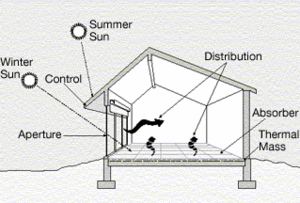Passive solar building design facts for kids
Passive solar building design is a smart way to build homes and other buildings. It uses the sun's energy to heat buildings in winter and keep them cool in summer. This is done without using any machines or electricity. Think of it like a plant using sunlight to grow.
This method is also called climatic design. It means designing a building to work well with the local weather. Key things to consider are where windows are placed and what kind of glass they have. Also important are insulation, materials that store heat (called thermal mass), and ways to block the sun (shading). Passive solar design is easiest to add when a building is first built. But older buildings can also be updated to use these ideas.
Contents
What is Passive Solar Design?
Passive solar design is a way to use the sun's energy naturally. It helps to heat and cool buildings without using much power. It's called "passive" because it doesn't need fans, pumps, or other electrical devices. Instead, it uses the building's own parts to manage heat.
How Does Passive Solar Design Work?
Imagine your home as a giant solar collector. In winter, windows let sunlight in. This sunlight warms the walls and floors. These parts then store the heat. Later, as the sun goes down, the stored heat slowly releases into the room. This keeps the building warm.
In summer, the design helps keep the heat out. Special shading or window placement can block the strong summer sun. This stops the building from getting too hot. It's all about working with the sun's path in the sky.
Key Parts of Passive Solar Design
To make a building passive solar, several important parts work together. These parts help collect, store, and distribute heat. They also help keep unwanted heat out.
Window Placement and Glazing
Windows are very important in passive solar design. They are usually placed on the side of the building that gets the most sun in winter. This is often the south side in the Northern Hemisphere. The type of glass, called glazing, also matters. Some glass lets in a lot of heat, while others block it.
Thermal Insulation
Insulation is like a warm blanket for your house. It helps keep the heat inside during winter. It also stops heat from getting in during summer. Good insulation means less heat escapes or enters through walls, roofs, and floors. This makes the passive solar system work better.
Thermal Mass
Thermal mass refers to materials that can store a lot of heat. Think of concrete, brick, or even water. These materials absorb heat from the sun during the day. Then, they slowly release that heat when it gets cooler. This helps to keep the indoor temperature steady and comfortable.
Shading
Shading is key for keeping buildings cool in summer. Overhangs, awnings, or even trees can block the high summer sun. This stops too much heat from entering through windows. In winter, when the sun is lower, these same shades might let the sun in. This smart design helps control the temperature all year.
Benefits of Passive Solar Design
Using passive solar design has many good points. It can save a lot of energy, which means lower electricity bills. It also makes homes more comfortable by keeping temperatures steady. Plus, it's good for the environment because it uses clean, renewable solar energy.
New Buildings and Retrofitting
It's easiest to include passive solar ideas when a new building is being planned. Architects can design the building from the start to use the sun's energy. However, older buildings can also be updated. This is called retrofitting. It might involve adding new windows or insulation to improve energy use.
See also
 In Spanish: Tecnología solar pasiva para niños
In Spanish: Tecnología solar pasiva para niños


